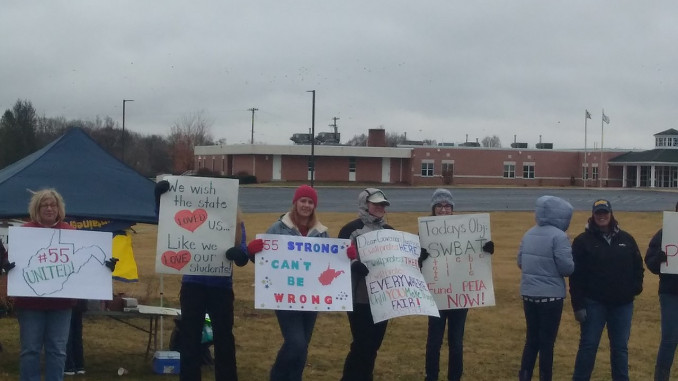
February 22, 2023 marks the five-year anniversary of the start of the historic nine-day teachers’ strike in West Virginia. The strike took place across 55 counties and involved 20,000 classroom teachers and thousands of other employees who shut down schools, swarmed the state capital building, and at times even took over parts of it. The strike was unique in that it included workers across unions and job sectors. That is to say, teachers and other school personnel stood together on the picket line.
Today in the United States, in inflation-adjusted terms, teacher salaries have declined by almost 4 percent over the past decade, and by more than 11 percent since the 2009 recession. Teachers in West Virginia are still among the lowest paid in the country. In 2018, West Virginia teachers had not had across-the-board raises for years. Teachers were working without a labor contract. It was not just declining salaries and no contract; West Virginia teachers were enraged over rising costs to their health insurance plans. School districts were trying to make employees wear Fitbits, and if teachers did not reach a certain number of steps per day, the premiums on their health insurance would go up. On top of this, there have been decades of bipartisan corporate reform which has led to student testing tied to teacher evaluations, the expansion of privatized charter schools, and the erosion of the professional status of teachers. All of this is still happening today.
The result of the 2018 strike was a 5 percent raise for all public employees in the state, not just teachers. This was won because the teachers disregarded union leaders’ advice to return to work when the governor first promised only them the raise. They met in malls and union halls, used Facebook as an organizing tool, and made decisions among themselves, apart from their union officials. The strikers in West Virginia and Arizona turned down raises that excluded support staff and other public workers. They put aside union labels, and professional status, to stand in solidarity with fellow colleagues, and remain on the picket line until their raise was enacted in law.
Another victory of the West Virginia strike was how it inspired teachers to mobilize and build rank-and-file militancy throughout the state, but also across the nation and even in countries around the world. For decades in the United States, in both red and blue districts, budget and tax policy have been used to break down social services, attack public industries, undermine unions, and transfer wealth upward, all while making the lives of working people harder. Austerity and privatization have been driving federal and state economic policy for decades. Public schools in particular have experienced deep budget cuts, as state funds have been funneled to charter schools, and salaries and school budgets have not kept up with inflation.
The West Virginia strike of 2018 was a part of a wave of strikes in red states, including Arizona and Oklahoma. The strikes were powerful examples of rank-and-file led uprisings in so-called “right-to-work” states, which have seen the steepest cuts in school funding and sharpest erosion of teacher pay and benefits. In West Virginia, an area historically led by strong mining unions, worker power had been greatly diminished. These strikes marked a resurgence in worker militancy against the cuts that have been driving federal and state economic policy for decades.
The West Virginia teacher strikes raised hopes that a long awaited revival of organized labor may have finally arrived. Following the Janus decision of 2018, a decline in union membership had been predicted, but instead, from 2018-2019 the American Federation of Teachers grew by 100,000 members. Another important result was that public perception of the crisis facing education has shifted. For years, the media and both Democrats and Republicans alike had used educators as scapegoats and promoted billionaire-backed education reform. Following the West Virginia strike, an Associated Press NORC poll found that 78 percent of the U.S. population found teacher pay too low. The United States has the largest economy in the world. There is money to be had, but it must be allocated differently. As the Chicago Teachers’ Union Vice President, Stacey Davis, said, “there is money, and it will come from the rich.”
Since the 2018 strikes, there have been other powerful teacher strikes, in both red and blue states on the national and international stage. The Los Angeles and Chicago strikes were offensive actions to reverse the education policies imposed by corporate Democrats over the past two decades. Each highlighted “common-good demands” on behalf of students, as well as the broader community. These mobilizations are examples of teachers striking not just for better salaries, but also for their communities – stopping school closures, ensuring reasonable class sizes, and mandating adequate support staff for students. These demands are examples of what happens when workers and families unite for a better school, community and world.
The COVID pandemic has devastated the workforce in many job sectors, particularly nursing and education. After decades of cuts to pay, resources and staffing, workers have had enough and are seeking other opportunities. Before the pandemic, it appeared that teacher power was growing – union membership was increasing, strikes multiplying and rank-and-file organizing gaining strength. In the last few years, workers in other sectors (Starbucks, Amazon, etc.) have fought to unionize and win fair contracts. In this larger context of renewed worker militancy, what will the coming year have in store for teachers, school staff and the fight for public education?




